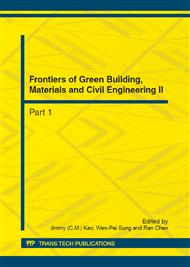[1]
Hartkopf, V., & Loftness, V., Global relevance of total building performance, Automation in Construction, 08-04, (1999) 377-393.
DOI: 10.1016/s0926-5805(98)00085-5
Google Scholar
[2]
Torcellini, P., Pless, S. Deru, M., Griffith, B., Long, N., and Judkoff, R., Lessons Learned from Case Studies of Six High-Performance Buildings, National Renewable Energy Laboratory, 2006.
DOI: 10.2172/884978
Google Scholar
[3]
USGBC, LEED Reference Guide for Green Building Design and Construction, the U.S. Green Building Council, United States, 2009.
Google Scholar
[4]
Taddonio, K., Building Technologies Program, Energy Efficiency and Renewable Energy, U. S. Department of Energy, Washington, 2011.
Google Scholar
[5]
Faludi, J., Green Building Simulation, World changing, 2007, Information on http://www.worldchanging.com/archives/007384.html.
Google Scholar
[6]
Zhu, Y., Applying computer-based simulation to energy auditing: A case study, Energy and Buildings, 38, (2006) 421–428.
DOI: 10.1016/j.enbuild.2005.07.007
Google Scholar
[7]
Fumo, N., Mago, P., Luck, R., Methodology to estimate building energy consumption using EnergyPlus Benchmark Models, Energy and Buildings, 42, (2010) 2331–2337.
DOI: 10.1016/j.enbuild.2010.07.027
Google Scholar
[8]
Department of Energy, Building Energy Software Tools Directory, 2011, Information on http://apps1.eere.energy.gov/buildings/tools_directory/doe_sponsored.cfm
Google Scholar
[9]
Crawley, D B. et al, Contrasting the Capabilities of Building Energy Performance Simulation Programs, University of Strathclyde, Glasgow, 1999.
Google Scholar
[10]
Hui, S C M. & Cheung, K P., Application of Building Energy Simulation to Air-conditioning Design, the University of Hong Kong, Hong Kong, 1998.
Google Scholar
[11]
Parsons, R. et al, 2005 ASHRAE HANDBOOK: Fundamentals: Inch-Pound Edition, Amer Society of Heating, Washington, 2005.
Google Scholar
[12]
Roderick, Y., McEwan, D., Wheatley, C., Alonso, C., A comparative study of building energy performance assessment between LEED, BREEAM and Green Star schemes, Integrated Environmental Solutions Limited, London, 2008.
Google Scholar
[13]
Sims, LC., LEED Green Associate Study Guide 2009 Edition, Studio4 LLC, Washington, 2010.
Google Scholar
[14]
Lee, WL. & Burnett, J., Benchmarking energy use assessment of HK-BEAM, BREEAM and LEED, Building and Environment, 43, (2008) 1882–1891.
DOI: 10.1016/j.buildenv.2007.11.007
Google Scholar
[15]
USGBC, LEED Reference Guide for Green Building Design and Construction, the U.S. Green Building Council, Washington, (2009)
Google Scholar
[16]
SOM, "High Performance" Sustainable Measures, Chicago, (2007)
Google Scholar
[17]
ASHRAE Standing Standard Project Committee, ASHRAE Standard 90.1-2007 Energy Standard for Building Except Low-Rise Residential Buildings, Atlanta, (2007)
Google Scholar
[18]
Ministry of Construction, Design standard for energy efficiency of public buildings [S], GB 50189-2005, Beijing, 2005.
Google Scholar


